HOME >> CHINA, METRO SHANGHAI
Raising a racket!
By Ni Dandan Source:Global Times Published: 2014-10-13 17:23:01
Behind the scenes at the 2014 Shanghai ATP Masters
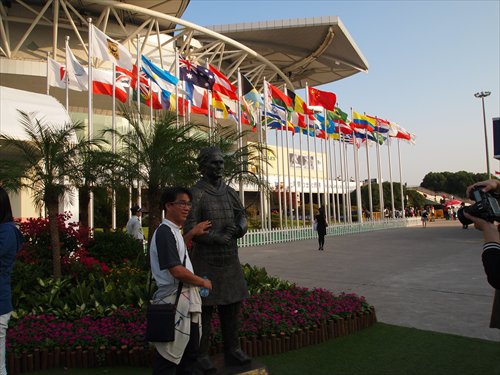
This is the sixth year for the Shanghai ATP Masters. Photo: Ni Dandan/GT
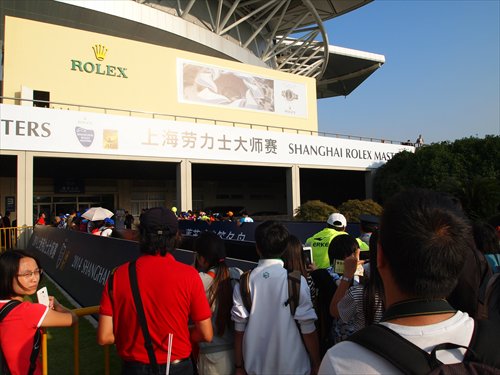
Fans crowd the players' entrance to see or ask for autographs from the stars. Photo: Ni Dandan/GT
For the past week Xinzhuang Station at the end of metro Line 1 was the key transportation hub for tennis fans. Packed shuttle buses left every few minutes for the Shanghai Qizhong Tennis Center where the 2014 Shanghai ATP Masters 1000 games were being staged.
This tournament is one of the nine ATP Masters 1000 tournaments in the world and is the only such tournament to be staged outside North America and Europe. This is the sixth year for this tournament in the city.
Over the past week, while crowds of fans excitedly surrounded the players' entrance for a glimpse or an autograph of the stars, there were many other people working behind the scenes to help keep the tournament going and the players playing at their peak on the courts.
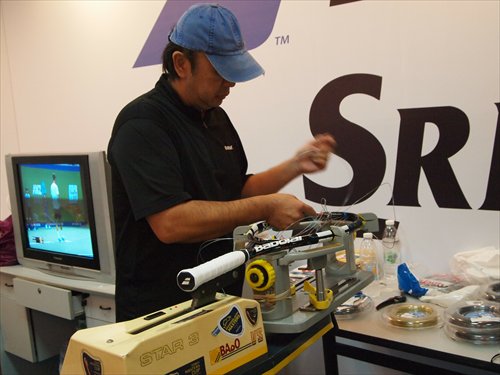
John Li from Taiwan is busy working on a stringing machine. Photo: Ni Dandan/GT
Stringing it out
When a player arrives on a court with a bag of rackets, don't assume they are all the same and the spare rackets are there just in case someone loses their temper and breaks one. The way a racket is strung is vital for the way it performs in play. When the strings on a racket begin to lose tension because of wear or age, it's time for the stringers to get to work.
At this year's Shanghai Tennis Masters, a team of four racket stringers worked throughout the tournament stringing rackets for players whenever they were needed.
"Please give me 20 minutes to finish this racket." When the Global Times met John Li at the stringers' workroom, he had just been given an urgent restringing order and was busy on a stringing machine. "It happens all the time. Some players have a habit of delivering their rackets for stringing just before their games start. We have to race against time."
Li, from Taiwan, is the leader of this four-member team - two come from Japan and the other from Hong Kong. Each has more than 10 years experience.
With 22 years of experience behind him, Li has been a frequent visitor to tennis tournaments in Shanghai. "The first time I came here was for the 1998 Heineken Open Shanghai."
A typical day at the tournament, for Li, starts at 6:30 am when the team arrives on site. Their days start early in the morning but end only after the last match of that day has concluded. Over this period, requests for stringing can come anytime and the workload is unpredictable. "Normally we are busier during the first half of the tournament when there are more matches."
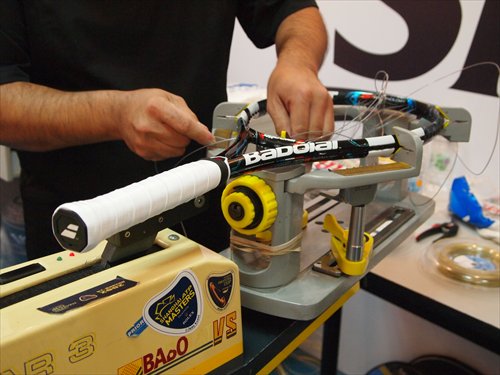
How a racket is strung is vital for the way it performs. Photo: Ni Dandan/GT
Enormous pressure
On the second day of this year's tournament, more than 80 rackets arrived for restringing almost at the same time. "The pressure was enormous. What made it worse was that we had to look after the workroom's reception desk and do the stringing as well." Li said that at bigger events like Grand Slam tournaments stringers didn't have to handle the reception desk and could concentrate on their work.
These stringers take an average of 30 minutes to string a racket. Under pressure they can complete a racket within 20 minutes or even 15. "This doesn't affect the quality of our work. We've been working at the Shanghai Masters for several years and the only complaint we have had was from a player who said we charged too much!" This year it cost players $30 to have a racket strung.
Li said each player has his or her unique requirements for string tension and usually a player prepares about four rackets for a match. These rackets have different string tensions so a player can choose the right racket depending on the wind or temperature.
The string tension on a tennis racket has to be set evenly across all the strings. Each of the main strings that run from top to bottom and the cross strings are pulled to a set tension on racket-stringing machines. String tension is measured in pounds with higher pound tensions resulting in tighter strings.
In the stringers' workroom at the Qizhong Tennis Center, Li and his team work steadily with their machines and rackets, deftly threading the strings and adjusting the pressure. "We can tell where it is too loose by plucking the strings. We can't make even one mistake throughout the process. It's a job that requires a lot of practice and experience."
Racket stringing is physically demanding but for professional stringers it can be financially rewarding if they get to work in different tournaments throughout the year. For Li the attraction of the work is that racket stringing is an art. "I enjoy having to work at speed when I am under pressure to complete a racket quickly. I feel really good by getting high-quality work done efficiently."
A vital role
When physiotherapists appear on court, spectators know something could be wrong with one of the players and the match might be called off. They play a vital role in the tournaments and are often the key between a player's success or painful injury.
The ATP World Tour has a team of 11 physiotherapists and Australian Paul Ness, with 15 years experience behind him, was on duty at the Shanghai Masters.
Many would think that these physiotherapists lead a glamorous life traveling to the great cities around the world and mixing with the finest tennis players. But when asked if he thought his job was glamorous, Ness gave a yes and no answer. "We visit wonderful places like Shanghai and can see some magnificent tennis. There are also long hours to work (think day and night sessions) and often many days in a row. Some of the physio guys would have been working in New York at the US Open for 23 days straight. There is also the stress of having to make critical treatment decisions with time constraints."
Like Ness, the ATP World Tour physiotherapists have studied physiotherapy and most have postgraduate degrees in sports physiotherapy. All are very experienced in treating players at all levels and are skilled in specific massage, taping, dry needling and cupping treatments among many processes.
Spectators only see the dramatic aspect of their work, when they have been called to the court. Ness said that during a game tennis players can experience sudden problems with their ankles, backs or muscles. They can suffer cramps or blisters, which can affect their performance. Players ask the chair umpire to call a physiotherapist to assess their injuries on court and determine if a medical timeout is required.
But most of a physiotherapist's work is done off the court. On an average day in a tournament, a physiotherapist has to be in the treatment room at least an hour before the start of play. "The first hour can be quite hectic preparing all first-up players for their matches. Match preparation includes taping joints to prevent injury, covering blisters, warming up tight muscles and loosening stiff backs, necks, shoulders and elbows amongst other things," Ness explained.
In the early part of the week when there are more matches and more players in the tournament, physiotherapists work long and busy days, grabbing meals when they can. Toward the end of a tournament, the workload drops off but that is when they have to attend to the paperwork and prepare their reports.
Although Ness listed some of challenges he encounters in his job, like the hardship of constant travel, jet lag, flight delays, different foods, language barriers and a lot of time away from home, he did say he wouldn't want to change his life.
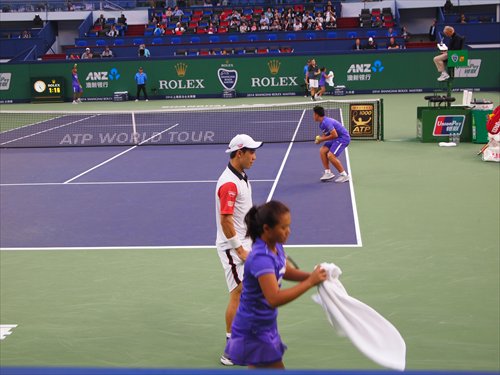
Ball girls and boys working at the court: it's a physically demanding job. Photo: Ni Dandan/GT
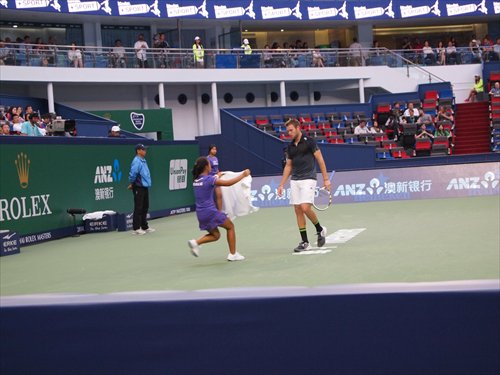
A ball girl runs to hand a towel to Jack Sock. Photo: Ni Dandan/GT
A passion for the game
This year, more than 100 ball boys and girls worked at the Shanghai Masters tournament. They range from primary school pupils to college seniors but they all have a passion for tennis.
Pei Xinhong is a veteran ball girl and plays for the Xuhui district tennis team. Her love for tennis and admiration for Roger Federer first motivated her to apply to be a ball girl at the Shanghai Masters five years ago and since then she's been working at the tournament every year.
"It's great fun getting so close to all the tennis greats. But don't think we talk to them a lot. We just stand near them. Occasionally they talk to us but they just ask us for balls or towels. Even so that's good enough for me," she laughed.
The ball boys and girls work on the courts for an hour at a time before being given a break. This year's Shanghai Masters saw several closely contested three-set matches which meant longer hours for some of them.
One thriller match between Roger Federer and Leonardo Mayer lasted until nearly 1 am on the center court, where Gu Wu was working. "Of course it's a physically demanding job. To qualify to be a ball boy you have to pass fitness tests. Usually we spend 4 hours a day on court which is easy to handle." Gu first served as a ball boy at the Shanghai Masters in 2007.
Some of the experienced ball boys and girls now know the habits of some of the players well. Pei said Gilles Simon tends to ask for the towel after every point he plays. "Ball boys have more to do if they are standing behind Simon."
But as the center of attention sometimes they encounter problems. Pei said she was hugely embarrassed when she had to put Jo-Wilfried Tsonga's towel on the ground during a doubles match.
"The doubles matches don't provide stools for the players' towels and ball boys and girls don't actually have to hand them the towels. But Tsonga asked for one so I got it for him. Then I had to put the towel on the ground - there was no other place for it. He didn't worry about it. Most of the players are nice."
It's not all fun though - there are dangers. Pei talked about the incident in the 2012 Shanghai ATP Masters where a ball boy was struck by a serve and was rushed to hospital.
These volunteers do get trained to get out of the way quickly when a tennis ball hurtles toward them but after a long hard match, tiredness can affect their concentration on court.
"For a match involving Federer or Nadal, who have very fast serves, less experienced ball boys are only rostered on for a hour and then rested for two before returning to court," Pei said. "This helps them recover properly."
Posted in: Society, Metro Shanghai